His paintings were very popular in his time, and are still popular today, over 400 years later.
In the painting "Children's Games", he shows children playing all sorts of games. Children today still play versions of some of the games shown.
He liked to paint a lot of small figures in a large space.
Another well-known painting by Bruegel is The Tower of Babel which depicts the Bible story of the efforts of men who aspired to build a city and a tower which would reach to heaven. In the same year 1563 he also painted a smaller picture of the tower of Babel which is called The Little Tower of Babel.

According to one writer who lived during Bruegel's time, the artist would show up uninvited at local weddings and village fairs. If he and his friend were going to a wedding, they would dress up as peasants, buy gifts for the bride and groom, pretend to be friends of the families and "crash" the party. They would mingle among the guests and visit with them. In this way he got ideas for his paintings and they were authentic.
In the painting "The Peasant Dance" the colors are not quite as bright as the vivid colors in "The Peasant Wedding". Notice the miniaturization of the woman and child in the foreground of the picture. They are out of proportion to the rest of the figures in the painting.
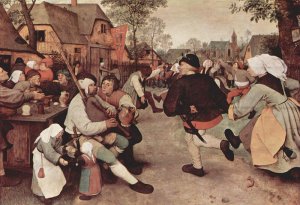
Peasant Dance
Enlarge
Enlarge
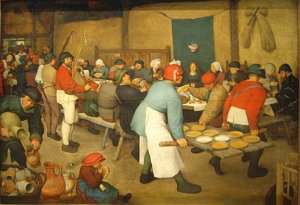
Peasant Wedding
Enlarge
Enlarge
"Landscape with the Fall of Icarus" is a painting which depicts the story of Icarus and his tragic end as he drowns in the sea. (Observe his legs as he goes under the water in the lower right-hand corner of the picture). The painting includes high mountains, but there were no mountains in the area where Bruegel lived. Once he traveled to Italy to study the works of the great artists there. He was able to view the Alps and he sketched many pictures of the tall mountains. When he returned home he painted landscapes and included the ideas he had gained on his trip. One biographer said that Bruegel "swallowed the mountains on his Italian trip so he could spit them out later in his studio".
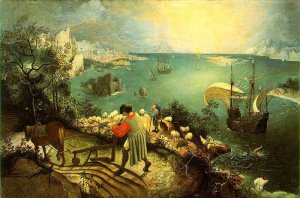
He was called Pieter the Elder. He had two sons who became famous painters. The older of them was named Pieter after his father, and he was called Pieter the Younger or sometimes "Hell Bruegel" because of the gloomy pictures he painted. His second son Jan was called "Velvet Bruegel" or "Flower Bruegel" because he painted rich bouquets of flowers. His grandsons also became artists. This was quite an artistic family.
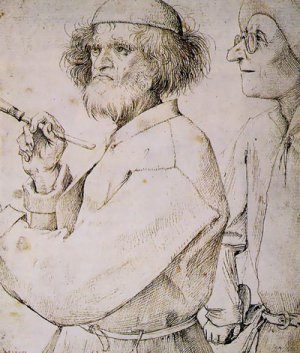
This biography was written by Patsy Stevens, a retired teacher.
References:
Hammacher, A.M., and R. Hammacher Vandenbrande. Flemish and Dutch Art. New York: Franklin Watt, Inc, 1965.
Order
Kostner, Thomas, and Lars Roper. 50 Artists You Should Know. New York: Prestel, 2006.
Order
Wilder, Jesse Bryant. Art History for Dummies. Hoboken, NJ: Wiley Publishing Inc, 2007.
Order

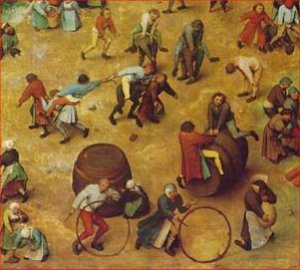
 A frequent question:
A frequent question: